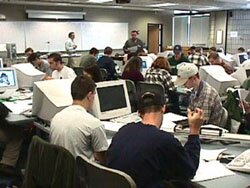| |
|
"I was able to jump right into MATLAB [for the first time] without being intimidated and realize that it was a tool rather than the solution."
"Being able to see our design tested and working in the software helped make the concepts sink in."
"The technology was helpful because you can simulate your design and get a real "hands-on" feel for the hardware."
Foundation Coalition Students
Technology-Enabled Learning
Faculty have used technology in numerous ways: Power Point presentations, course web pages, web-based courses, integrating computers into classrooms, using laboratories as learning activities, etc. Here, the focus is on putting computer-related technologies in the hands of students on a routine basis to facilitate their learning, change their learning objectives, and reshape their learning processes. Several examples are presented to illustrate the types of changes that have been made.
Example: Creating Interactive Learning Environments across the Foundation Coalition
| Partner institutions across the Foundation Coalition (FC) have built or renovated classrooms to facilitate active/cooperative learning, student teams, and everyday use of technology in the classroom. Like other FC partners, the University of Alabama has completely restructured its introductory curricula for Computer Science, Computer Engineering, and Management Information Systems majors. Faculty members teach introductory courses using active learning remodeled classrooms. All class materials, e.g., syllabus, assignments, and lecture notes, are available on course web sites, and students can preview material before class and come prepared with questions. In addition, class discussions and on-line checking of grades are available via the web site. FC partners can share designs, cost estimates and assessments for numerous classroom designs, both new and remodeled. |
 Students at the University of Massachusetts-Dartmouth use computers in the classroom to monitor, display, and analyze data on objects moving on the air track.
Students at the University of Massachusetts-Dartmouth use computers in the classroom to monitor, display, and analyze data on objects moving on the air track.
|
Example: Teaching Circuits at Texas A&M University
| Faculty teach circuits in a classroom in which students use laptop computers, National Instruments (NI) virtual instruments, and a NI breadboard with a computer interface (designed in conjunction with faculty at A&M). Students perform experiments in the classroom to reinforce concepts presented in lecture. For example, students can design a single stage amplifier, predict its performance via analysis and simulation, construct the amplifier and compare measured and predicted performance. |
|
Example: Teaching physics via modeling at Arizona State University1
Through designing and verifying models students build their conceptual understanding of physics. For each physics topic students work through two stages of the modeling cycle: model development and model deployment. In model development, students describe a physical situation, collect data, formulate a model that reflects relevant features of the situation, and verify their model using measured data. In model deployment, students apply their model to new situations. The generic and flexible format of the two stage modeling cycle can be adapted to any physics topic.
See: http://modeling.la.asu.edu/modeling.html
Example: Studio classrooms at Rensselaer Polytechnic Institute2
Studio classrooms integrate lectures, laboratories, and recitations into a single physical space. Students listen to explanations and then conduct experimental explorations to reinforce their understanding of concepts. A typical 2-hour studio physics session, for example, reviews assigned readings and exercises. Then students move to an experiment that may involve a motion detector with a computer interface to measure the velocity of a falling golf ball. The session often ends with a "mini-lecture" that summarizes what students have learned and assigns homework.
See: http://ciue.rpi.edu/studioteaching.html
Example: Rose-Hulman requires notebook computers3
Students use applications such as Maple, MATLAB and Excel to perform routine symbolic, numerical and graphical computations throughout their engineering curricula: in-class activities, homework and examinations. As a result, they focus less on rote manipulation and more on concepts, realistic problems and reasonable answers. In a physics laboratory, for example, students acquire and graph data to help them visualize the magnetic field of a pair of Helmholtz coils.
See: http://www.rose-hulman.edu/Class/CalculusProbs/
See: http://www.rose-hulman.edu/Users/groups/packets/HTML/packetpg.htm
|
|
References for further information
- Wells, M., Hestenes, D. & Swackhamer, G., "A modeling method for high school physics instruction," Am. J. Phys. 63: 606-619, 1995.
- Wilson, J. and W. Jennings, "Studio Courses: How Information Technology is Changing the Way We Teach, On Campus and Off," Proceedings of the IEEE, vol. 88, no. 1, January 2000, pp. 72-80.
- Kiaer L., D. Mutchler, and J. Froyd, "Laptop Computers and the Integrated First-Year Curriculum at Rose-Hulman Institute of Technology", CACM, 41(1), Jan. 1988, pp. 45-49.
- Kolb, D.A., Experiential Learning: Experience as the Source of Learning and Development. Englewood Cliffs, New Jersey: Prentice-Hall, 1984.
- Harb, J., S. Durrant, and R. Terry, "Use of the Kolb Learning Cycle and the 4MAT System in Engineering Education," J. Eng. Ed., 83(2), April 1993, pp. 70-77.
- Chen, J., M. Ellis, J. Lockhart, S. Hamoush, C. Brawner and J. Tront, "Technology in Engineering Education: What Do the Faculty Know and Want?" J. Eng. Ed. 89(3), July 2000, pp. 279-283.
|
 |
 |
© 2001 Foundation Coalition. All rights reserved. Last modified
|
 |
| |
|